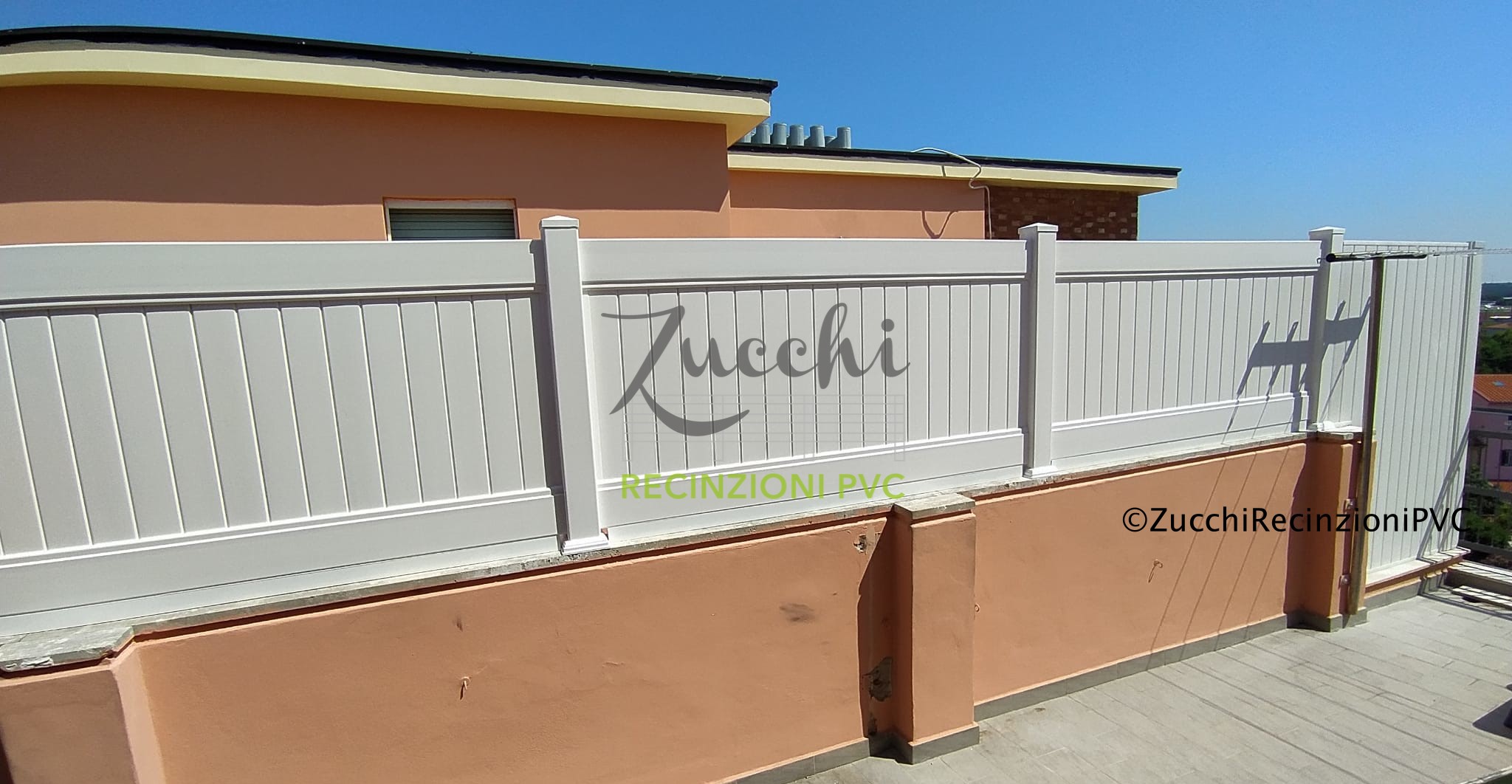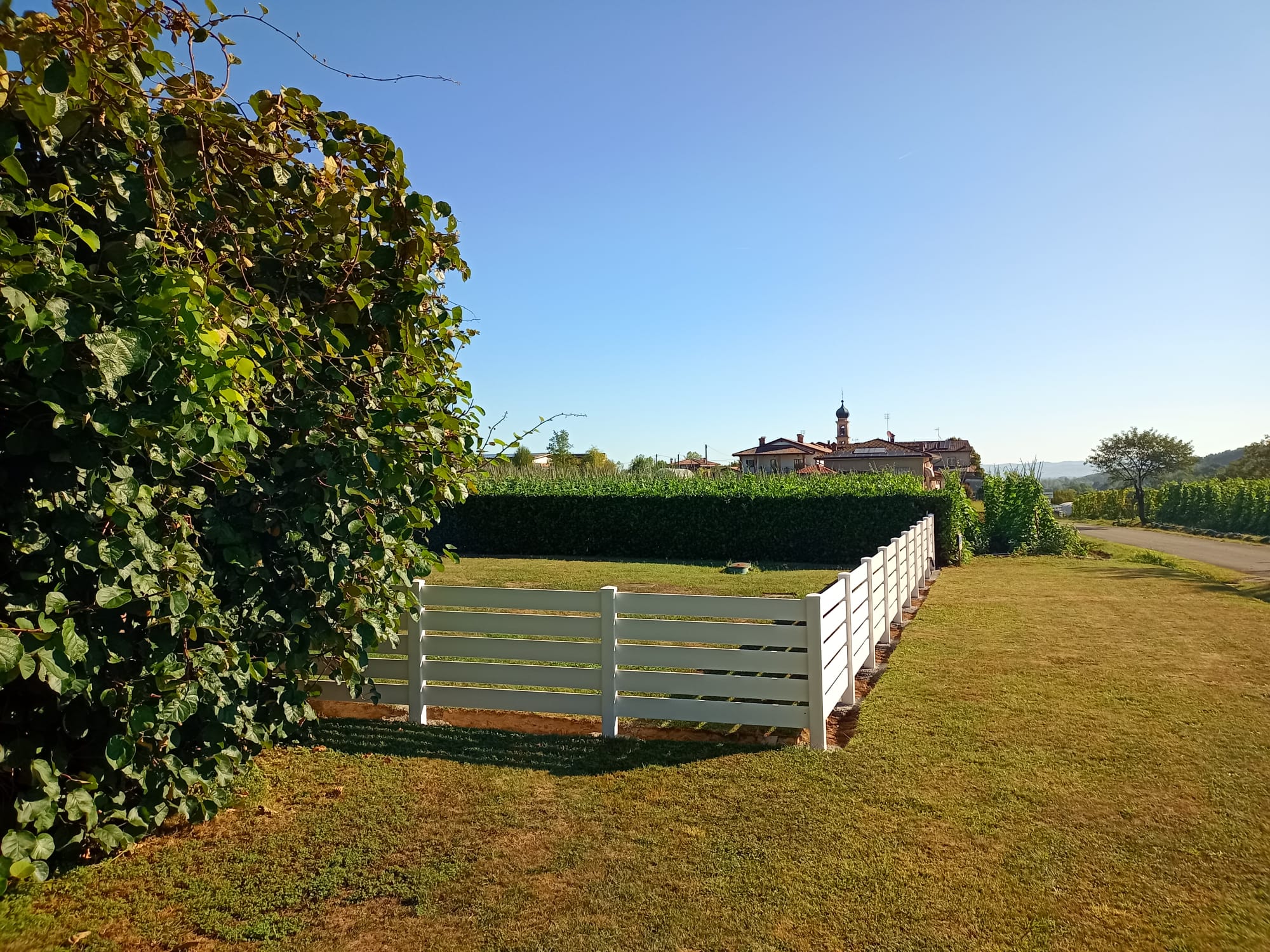Aesthetics, security, logistics: every space has its own requirements
When thinking about a fence for a commercial space, it is easy to fall into the trap of “just fence.” But every showroom, corporate parking lot, or display area has its own unique needs. And no, they are not all solved with the same hardware store net. Whether you are demarcating the entrance to an elegant design showroom, a corporate garden or a customer parking lot, the perfect solution cannot be a random choice. Every space speaks, communicates something. It’s up to you to decide what it should say. That’s why today we talk about aesthetics, security, and logistics, the three ingredients that make a top modular fence really work for your business.Aesthetics: when design makes a difference
Yes, even a fence can be beautiful. In fact, it has to be, if you want to impress from the first glance. Imagine walking through the gate of a modern furniture showroom. You find a rusty, crooked fence, perhaps with a chain. What do you think? Surely you don’t expect manic attention to detail inside, do you? High-end modular fencing allows you to choose colors, finishes and lines consistent with your company’s visual identity. Whether you prefer a minimal style in painted steel or a warmer natural wood effect, you can match it to your space. The great thing is that you don’t have to upset anything: just the right module is enough to elevate the style of the entire perimeter, as if it were an extension of the interior decor. And you know what’s even better? That the modules also fit irregular or curved surfaces, giving a personalized touch without going crazy with a thousand custom jobs. And remember: design is not just form, it is also experience. A well-done fence helps customers orient themselves, enter, leave, and feel welcome.Security: protecting without shutting the world out
Safety is a priority, but it should never become a visual or mental barrier. Commercial space also thrives on openness, transparency and welcoming. You don’t want to turn it into a fortress, do you? Top-of-the-line modular fences allow you to reconcile protection and visual lightness, avoiding that annoying “cage” effect. If you work in the city or in an area with foot and car traffic, you can choose modules that protect your spaces without hiding them. They are perfect for car showrooms, stores with outdoor displays, or corporate courtyards where customers and suppliers pass by. And it’s not just about theft or vandalism: delimiting spaces well helps prevent accidents, distractions, and improves the movement of people. You can incorporate controlled opening systems, turnstiles, integrated lights, and smart access, all already set up in the modules. Security today is also responsibility to those who enter your spaces. Make them feel protected, but not a prisoner.Logistics: the true test for any commercial space
Here we enter the beating heart of efficiency: logistics. Those who manage a business area know how complicated it can be to manage inputs, outputs, deliveries and internal routes. Fencing, if designed poorly, can become an obstacle. If designed well, it is a silent and brilliant ally. With the right modules you can create customer aisles, van lanes, separate loading/unloading zones, and safe walking paths. And all this without having to resurface floors, demolish walls or invent complicated solutions. The beauty of modular systems is that you can change them over time. Have you expanded the warehouse? Have you opened a second customer entrance? Just add or relocate existing modules. No endless construction sites, no chaos-a smart solution that grows with you. And if you also want to look good at trade shows or temporary events, you can use demountable modules that turn any space into a branded and organized area. Think of the convenience of assembling a stylish fence for your outdoor booth in two hours and dismantling it without a trace.Choose based on space, not fashion
There is no perfect fence for everyone. But there is the right one for your space that meets aesthetic, functional and logistical needs together. It’s not just about choosing a nice color or a good material. It’s about understanding how your space works: What paths it needs to facilitate, what risks it needs to reduce, what image it needs to convey. And you are the only one who knows what is really needed. The good news? With today’s modular systems you can choose, change, evolve. You don’t have to get stuck in a rigid structure: the fence adapts to you, not the other way around.Comparison of materials: steel, wood composite, aluminum
When you choose a fence for your commercial space, you’re not just marking a boundary-you’re communicating a message. And that message changes completely depending on the material you decide to use. Steel, composite wood, and aluminum are the three undisputed kings of top-of-the-line modular fencing. But each has its own character, strengths and little quirks to consider. Let’s look at them together so you know right away which material speaks to you the most.Steel: the classic that doesn’t fail (but weighs!)
If you want a material that screams “solidity” as soon as you look at it, then steel is your best ally.Steel fences immediately give a sense of protection, seriousness and strength-perfect for warehouses, logistics locations and “tough” corporate spaces. When you choose steel, you are putting all your eggs in the durability basket. It doesn’t fear high winds, or blows, or aggressive weathering.
And with the right treatments (such as hot-dip galvanizing) it can withstand even industrial environments or near the sea. But-there is always a but. Steel is heavy: both physically and in terms of installation. It takes longer to install, and if you have to make changes in the future, be prepared for a little extra labor. It is not the most flexible choice if you plan to change layouts over time or disassemble and reassemble. Aesthetically? It fits well with modern and industrial styles, especially when painted in neutral or anthracite colors. It can also be customized with laser decorations, but it tends to communicate sturdiness rather than lightness.
Composite wood: natural but without the hassles of wood
If you love the warm effect of wood but hate the idea of having to treat it every couple of months, composite wood is for you.
We are talking about a hybrid material, made from a mixture of plastic resins and recycled wood fibers.
The result? A material that is beautiful, durable, and won’t crack in the first rain. Composite wood is perfect if you want to give your spaces a more “human” feel.
Imagine it around a corporate garden, a cozy courtyard, a relaxation area for clients-it works great. Aesthetically, it is versatile. You can choose from many wood effects: light, dark, veined or smooth.
And the best thing about it? It doesn’t need any special maintenance: an occasional wash, and you’re good for years. Be careful where you install it, however: if your space is very exposed to heavy loads or frequent shocks, it may not be the best choice.
Although durable, it is not armor. It is a softer material, from “gentle” environments, not from pallet unloading. On the green side, it is popular because it uses recycled materials and lasts a long time without the need for toxic paints.
Great for those who want an eco-friendly image without sacrificing an attractive look.
Aluminum: light, modern and smart
And finally he, the prince of versatility: aluminum.
Lightweight, elegant, easy to work with, and virtually eternal if treated well. Modular aluminum fences are ideal for those who need flexibility, quick assembly and zero maintenance. Perfect for showrooms, customer entrances, representative courtyards or outdoor areas of stores with a contemporary look. Aluminum won’t rust, even if you put it under a downpour for days.
And thanks to powder coating, you can have it in any color, including wood-effect, corten or gloss finishes. The interesting thing? It’s super lightweight, so you can change layouts easily if you change the layout of the space.
And if you combine it with accessories such as LED lights, vertical plants or decorative panels, it can become a real scenic element. From a security point of view, it is resistant to light impacts and very stable if anchored well. Of course, it doesn’t have the mass of steel, so maybe you don’t choose it to protect an armored warehouse.
But if you want to combine aesthetics, functionality and practicality, aluminum is almost unbeatable.
Bonus? It is 100 percent recyclable, which makes it beloved in sustainable or LEED-certified projects.
What is the right material for you?
The answer, as always, is: it depends on your space and your goals.
There is no absolute best material, but there is definitely one that is best suited for your project. If you want to convey solidity and authority, go for steel. If you seek visual warmth and sustainability, composite wood will put a smile on your face.
And if you want freedom, speed, and modern style, aluminum is the way to go. Think about it as if you were choosing the perfect suit for your retail space. Not everyone dresses up, not everyone looks good in a suit and tie.
But with the right materials, your space will communicate exactly what you want.
Modularity to adapt to irregular or composite surfaces
Have you ever tried to install something on a surface that is not perfectly straight?
Those moments when you notice that the ground is sloping, there are steps, unevenness, curves, odd angles, and maybe even a grate in the middle?
There, right there you realize that not all fences are the same. The good news is that modular top fences are made especially for this kind of situation.
They’re like those modular pieces of furniture that fit into any space and always save your decor. Only they do it–outdoors.
Let’s see together why modularity is your best ally when the terrain throws a tantrum.
The beauty of being flexible: modules that follow space
Let’s start with a truth: not all spaces are as straight as a golf course.
In reality, especially in commercial settings, you find yourself having to enclose composite areas, perhaps with multiple levels, odd angles or architectural inserts. Then how do you do it? You certainly can’t redo the ground to fit the fence. That’s where modularity comes in: it allows you to build your fence piece by piece, like a big puzzle. With the right modules you can follow the shapes of the space, creating flowing lines even where there are differences in height or curves.
You are no longer forced to “force” the design, but can listen to the space and respond intelligently. Basically, you become the designer of the perimeter, choosing height, slope, distance between modules, corners and finishes.
And the beauty is that, even if the space is complicated, the end result looks neat, consistent and professional. Do you have a flower bed in the middle of the path? No problem.
Need a curve around the parking lot? There’s the right form for that, too.
Difficult surfaces? Modularity makes your life easier
Many companies are discouraged when they see uneven surfaces: slopes, gravel, mixed asphalt, basalt or uneven concrete.
But you’ll be surprised to learn that you don’t need to redo everything from scratch.With top modular fencing you can adapt without breaking anything. Some systems offer adjustable posts or custom-made anchors, ideal for compensating for height differences or securely fastening to any surface.
Others provide panels that can be adapted in height or tilt, perfect for hilly areas or terraced gardens. In public spaces or outdoor showrooms, it often happens that you have to get around unexpected obstacles: manholes, poles, conduits, plants.
With a modular system, you can simply skip them, integrate them, or elegantly bypass them without resorting to half-baked solutions. Modularity is not only an aesthetic convenience, but also a smart technical choice.
You avoid extra work, you don’t waste time, and most importantly, you don’t get stuck with a rigid structure that you can’t change.
What if one day the space changes, such as due to construction or expansion?
Disassemble, move, reassemble. Like with LEGOs. Only much nicer to look at.
When flexibility becomes a competitive advantage
In commercial settings, showrooms or corporate environments open to the public, outdoor space plays an increasingly strategic role.
It is no longer just a perimeter: it is an element of image, functionality and branding. If you can build a fence that fits the space perfectly, you communicate care, precision and professionalism. Those who enter immediately sense that nothing is left to chance.
And this feeling is also reflected in the way the customer perceives your brand. In addition, modularity allows you to evolve over time. You can add modules with decorative panels, integrated planters, lighting or branded panels, depending on your future needs.
So your space grows with you, without having to throw anything away or do it all over again. If you participate in trade shows or temporary events, modularity becomes a key asset.
You can transport modules, assemble them quickly even on unfamiliar terrain, and always give a curated and consistent image. And the best part? Everything is customizable: colors, finishes, heights, accessories.
Even in complex spaces, you can achieve a harmonious look that is completely your own.
It’s not just a matter of aesthetics, but of design intelligence
Choosing a modular fence for irregular or composite surfaces is not just a matter of taste.
It is a way of designing more intelligently, thinking about functionality in the long run. You avoid mistakes, reduce future costs, and get a space that actually works, not just looks good.
Plus, you demonstrate attention to context and the ability to respond flexibly to real problems. The next time you look at a space that is difficult to fence, don’t say “it can’t be done.” Instead, ask yourself, “How can I modulate it?”
With the right tools, everything fits together perfectly. Even when the terrain throws a tantrum.
Checklist: 8 questions before purchase
Buying a modular fence is not like buying a couple of garden pots.
It is a choice that influences the style, security and organization of your commercial space for years to come. But don’t panic! You don’t need to be an architect or engineer to choose the right fence. You just need to ask yourself the right questions before you buy.
In this guide I take you step by step with a simple checklist.
-
What is the real purpose of the fence?
Do you want to demarcate? Protect? Organize? Hide something or highlight something else? Each goal completely changes the type of fence you need. A fence to protect a technical area is different from one to guide customers to the entrance.
And if you just want to improve the aesthetics of the perimeter, still different.
Ask yourself: what does this fence really have to do for me every day?
The answer is the first step in avoiding costly mistakes.
-
Which materials are best suited to my environment?
For example: composite wood is perfect for a cozy space, but perhaps unsuitable for busy industrial areas.
Also ask yourself: how much time can and do I want to devote to maintenance?
Because some materials just need to be installed and forgotten. Others-they want more attention than a living room plant.
-
Is the space regular or full of surprises?
We all dream of a nice flat rectangle, but in reality there are curves, steps, strange angles and unevenness everywhere.
Have you measured right yet? Have you checked for constraints such as manholes, gates or light poles to go around? A modular fence is perfect to fit, but you need to know what you are getting into before you order.
Measure everything, photograph the area and, if possible, do a small survey.
This question saves you a lot of headaches later.
-
How important is aesthetics to my business?
A beautiful fence that is consistent with your business style communicates order, professionalism and attention to detail. Choose colors, shapes and finishes that dialogue with your logo, architecture and existing materials. Do you have an industrial style? Go with dark metal. Do you love nature? Go for wood-effect finishes.
Never underestimate the aesthetic impact: fencing is the first impression you make on the outside.
-
How important is ease of installation to me?
Installing a fence can be a breeze–or an endless nightmare.
It all depends on the system you choose and how flexible it is. If you need a quick turnaround time or can’t afford disruptions, choose modular solutions that are pre-assembled or easy to retrofit on site.
Avoid products that require complicated machining or heavy customization on site.
A good question to ask is: How much do I want to make my life easier during installation?
-
What if I want to change something tomorrow?
The fence you choose today must be ready to change with you. Ask yourself: is the system repurposed? Can I move modules, add accessories, or reconfigure without starting all over from scratch?
If the answer is yes, you are on the right track.
-
What added value do I want to achieve with this choice?
It can guide, inform, stage, or simply tell who you are.
Ask yourself: will this fence really improve the perception of my space?
Or am I just choosing based on price or the first advice received? Reason in terms of visual, functional and communicative return.
Because every module you install speaks to your customer.
-
Do I have all the necessary information and permissions?
A misplaced form can turn into a fine, or worse, forced removal. And if you’re not sure, ask an engineer or the building department in your municipality.
Better to lose a day today than to have to dismantle everything in six months.







Leave A Comment